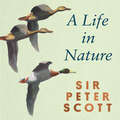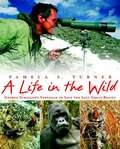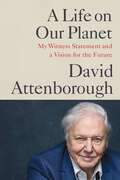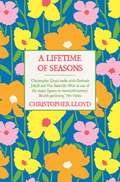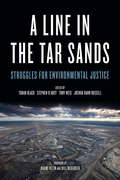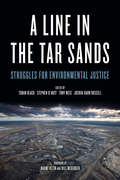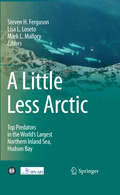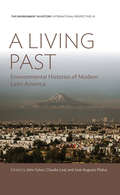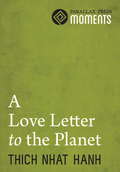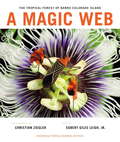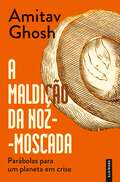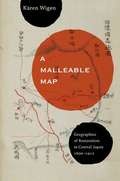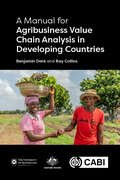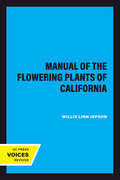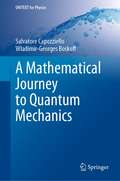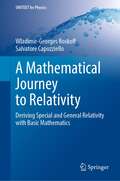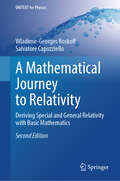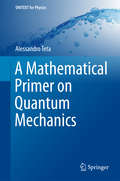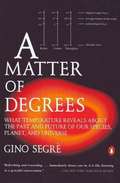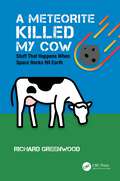- Table View
- List View
A Life In Nature
by Peter Scott'The Patron Saint of Conservation' Sir David Attenborough'Peter Scott was a huge influence on my childhood...Later on in life I had the good fortune both to meet and to interview him, and he remains, for me, a hero. His knowledge, his kindness to me and his generosity of spirit have remained an influence in my own sphere of natural history....To meet one's heroes can sometimes be a let-down. That was most certainly not the case with Peter Scott.' Alan TitchmarshA Life In Nature is a portrait of Peter Scott collected from his own conversations, articles and broadcasts including thoughts on expeditions to Lapland, Conservation and Africa, his travels in Europe and much more. Illustrated by Peter's own beautiful illustrations. Sir Peter Scott had a truly incredible life. He was the only son of legendary explorer Captain Scott. His godfather was JM Barrie and he was married to Elizabeth Jane Howard. He also represented Great Britain and Northern Ireland at sailing in the 1936 Berlin Olympic Games, winning a bronze medal. He founded the Wildfowl and Wetlands Trust and also helped to found the Worldwide Fund for Nature.This is a beautiful and timely re-discovered book, perfect for those who are interested in preserving our planet.
A Life In Nature
by Sir Peter Scott'The Patron Saint of Conservation' Sir David Attenborough'Peter Scott was a huge influence on my childhood...Later on in life I had the good fortune both to meet and to interview him, and he remains, for me, a hero. His knowledge, his kindness to me and his generosity of spirit have remained an influence in my own sphere of natural history....To meet one's heroes can sometimes be a let-down. That was most certainly not the case with Peter Scott.' Alan TitchmarshA Life In Nature is a portrait of Peter Scott collected from his own conversations, articles and broadcasts including thoughts on expeditions to Lapland, Conservation and Africa, his travels in Europe and much more. Illustrated by Peter's own beautiful illustrations. Sir Peter Scott had a truly incredible life. He was the only son of legendary explorer Captain Scott. His godfather was JM Barrie and he was married to Elizabeth Jane Howard. He also represented Great Britain and Northern Ireland at sailing in the 1936 Berlin Olympic Games, winning a bronze medal. He founded the Wildfowl and Wetlands Trust and also helped to found the Worldwide Fund for Nature.This is a beautiful and timely re-discovered book, perfect for those who are interested in preserving our planet.
A Life In Nature
by Sir Peter Scott'The Patron Saint of Conservation' Sir David Attenborough'Peter Scott was a huge influence on my childhood...Later on in life I had the good fortune both to meet and to interview him, and he remains, for me, a hero. His knowledge, his kindness to me and his generosity of spirit have remained an influence in my own sphere of natural history....To meet one's heroes can sometimes be a let-down. That was most certainly not the case with Peter Scott.' Alan TitchmarshA Life In Nature is a portrait of Peter Scott collected from his own conversations, articles and broadcasts including thoughts on expeditions to Lapland, Conservation and Africa, his travels in Europe and much more. Illustrated by Peter's own beautiful illustrations. Sir Peter Scott had a truly incredible life. He was the only son of legendary explorer Captain Scott. His godfather was JM Barrie and he was married to Elizabeth Jane Howard. He also represented Great Britain and Northern Ireland at sailing in the 1936 Berlin Olympic Games, winning a bronze medal. He founded the Wildfowl and Wetlands Trust and also helped to found the Worldwide Fund for Nature.This is a beautiful and timely re-discovered book, perfect for those who are interested in preserving our planet.
A Life in The Wild: George Schaller's Struggle to Save the Last Great Beasts
by Pamela S. TurnerIn this biography, Pamela S. Turner examines the amazing life and groundbreaking work of the man International Wildlife calls the worlds foremost field biologist. Schaller's landmark research revolutionized field biology, demonstrating that it is possible to study dangerous animals in their own habitats: mountain gorillas in Central Africa, predatory tigers in India, mysterious snow leopards in the Himalayas, and many others.
A Life on Our Planet: My Witness Statement and a Vision for the Future
by Sir David AttenboroughIn this scientifically informed account of the changes occurring in the world over the last century, award-winning broadcaster and natural historian shares a lifetime of wisdom and a hopeful vision for the future.See the world. Then make it better.I am 93. I've had an extraordinary life. It's only now that I appreciate how extraordinary. As a young man, I felt I was out there in the wild, experiencing the untouched natural world - but it was an illusion. The tragedy of our time has been happening all around us, barely noticeable from day to day -- the loss of our planet's wild places, its biodiversity. I have been witness to this decline. A Life on Our Planet is my witness statement, and my vision for the future. It is the story of how we came to make this, our greatest mistake -- and how, if we act now, we can yet put it right.We have one final chance to create the perfect home for ourselves and restore the wonderful world we inherited.All we need is the will do so.
A Lifetime of Seasons: The Best of Christopher Lloyd
by Christopher Lloyd'He was the best informed, liveliest and most innovative gardening writer of our times' GUARDIAN'Infuriating, irascible ... a brilliant gardener and a brilliant writer' Monty Don, ObserverChristo Lloyd was recognised as one of the foremost gardeners and garden writers of the 20th century. Here, for the first time, is the definitive collection of his best, most informative, and so often amusing, garden writing.Christo on gardening: Ours, in its humble way, is an art as well as a craft. At the same time it keeps us in touch with the earth, the seasons, and with that complex of interrelated forces both animate and inanimate which we call nature. It is a humanizing occupation.On weeding:Many gardeners will agree that hand-weeding is not the terrible drudgery that it is often made out to be. Some people find in it a kind of soothing monotony. It leaves their minds free to develop the plot for their next novel or to perfect the brilliant repartee with which they should have encountered a relative's latest example of unreasonableness.
A Line in the Tar Sands: Struggles for Environmental Justice
by Black, Toban; D'Arcy, Stephen; Weis, Tony; Kahn Russell, Joshua; Klein, Naomi; McKibben, BillTar sands “development” comes with an enormous environmental and human cost. But tar sands opponents—fighting a powerful international industry—are likened to terrorists; government environmental scientists are muzzled; and public hearings are concealed and rushed. Yet, despite the formidable political and economic power behind the tar sands, many opponents are actively building international networks of resistance, challenging pipeline plans while resisting threats to Indigenous sovereignty and democratic participation. Featuring contributions from Winona LaDuke, Bill McKibben, Naomi Klein, Clayton Thomas-Muller, Harsha Walia, Jeremy Brecher, Crystal Lameman, Melina Laboucan-Massimo, Yves Engler, Cherri Foytlin, Macdonald Stainsby, Yudith Nieto, Greg Albo, Brian Tokar, Jesse Cardinal, Rex Weyler, Jess Worth, and many more. The editors’ proceeds from this book will be donated to frontline grassroots environmental justice groups and campaigns.
A Line in the Tar Sands: Struggles for Environmental Justice
by Joshua KahnThe fight over the tar sands in North America is among the epic environmental and social justice battles of our time, and one of the first that has managed to marry quite explicitly concern for frontline communities and immediate local hazards with fear for the future of the entire planet. Tar sands "development" comes with an enormous environmental and human cost. But tar sands opponents—fighting a powerful international industry—are likened to terrorists; government environmental scientists are muzzled; and public hearings are concealed and rushed. Yet, despite the formidable political and economic power behind the tar sands, many opponents are actively building international networks of resistance, challenging pipeline plans while resisting threats to Indigenous sovereignty and democratic participation. Including leading voices involved in the struggle against the tar sands, A Line in the Tar Sands offers a critical analysis of the impact of the tar sands and the challenges opponents face in their efforts to organize effective resistance. Contributors include Angela Carter, Bill McKibben, Brian Tokar, Christine Leclerc, Clayton Thomas-Muller, Crystal Lameman, Dave Vasey, Emily Coats, Eriel Deranger, Greg Albo, Jeremy Brecher, Jess Worth, Jesse Cardinal, Joshua Kahn Russell, Lilian Yap, Linda Capato, Macdonald Stainsby, Martin Lukacs, Matt Leonard, Melina Laboucan-Massimo, Naomi Klein, Rae Breaux, Randolph Haluza-DeLay, Rex Weyler, Ryan Katz-Rosene, Sâkihitowin Awâsis, Sonia Grant, Stephen D'Arcy, Toban Black, Tony Weis, Tyler McCreary, Winona LaDuke, and Yves Engler.
A Little Less Arctic: Top Predators in the World's Largest Northern Inland Sea, Hudson Bay
by Lisa L. Loseto Ferguson Steven H Mark L. MalloryIn Arctic Canada, Hudson Bay is a site of great exploration history, aboriginal culture, and a vast marine wilderness supporting large populations of marine mammals and birds. These include some of the most iconic Arctic animals like beluga, narwhal, bowhead whales, and polar bears. Due to the challenges of conducting field research in this region, some of the mysteries of where these animals move, and how they are able to survive in such seemingly inhospitable, ice-choked habitats are just now being unlocked. For example, are polar bears being replaced by killer whales? This new information could not be more salient, as the Hudson Bay Region is undergoing rapid environmental change due to global warming, as well as increased pressures from industrial development interests. A Little Less Arctic brings together some of the world's leading Arctic scientists to present the current state of knowledge on the physical and biological characteristics of Hudson Bay.
A Living Countryside?: The Politics of Sustainable Development in Rural Ireland (Perspectives on Rural Policy and Planning)
by Tony VarleyBy examining a range of experiences from both the north and south of Ireland, this book asks what the ideal of sustainable development might mean to specific rural groups and how sustainable development goals have been pursued across the policy spectrum. It assesses the extent of commitment to a living countryside in Ireland and compares various opportunities and obstacles to the actual achievement of sustainable rural development. How different sectors of rural society will be challenged in terms of future survival provides an overarching theme throughout.
A Living Past: Environmental Histories of Modern Latin America (Environment in History: International Perspectives #13)
by José Augusto Pádua John Soluri, Claudia LealThough still a relatively young field, the study of Latin American environmental history is blossoming, as the contributions to this definitive volume demonstrate. Bringing together thirteen leading experts on the region, A Living Past synthesizes a wide range of scholarship to offer new perspectives on environmental change in Latin America and the Spanish Caribbean since the nineteenth century. Each chapter provides insightful, up-to-date syntheses of current scholarship on critical countries and ecosystems (including Brazil, Mexico, the Caribbean, the tropical Andes, and tropical forests) and such cross-cutting themes as agriculture, conservation, mining, ranching, science, and urbanization. Together, these studies provide valuable historical contexts for making sense of contemporary environmental challenges facing the region.
A Llama Is Not an Alpaca: And Other Mistaken Animal Identities
by Karen JamesonCombining scientific facts with the art of poetry, this is a humorous and educational picture book about animals that look alike. How do you tell a llama from an alpaca, an alligator from a crocodile, or a dolphin from a porpoise? The animal kingdom is full of creatures that look so similar to others that they are often confused for each other. A Llama Is Not an Alpaca pairs rhyming animal riddles with factual responses to both teach and engage young readers as they compare and contrast features of commonly misidentified animals. How many will you get right?!
A Log's Life
by Wendy PfefferOne stormy day a strong wind rages through the forest, causing an old oak tree to bend and sway. Lightning strikes; the tree crashes to the ground. Now it's a giant log.
A Love Letter To The Planet
by Thich Nhat HanhA passionate appeal for ecological mindfulness and strengthening our relationship to the Earth. Based on the best selling The World We Have.
A Magic Web
by Christian Ziegler Egbert Giles LeighThe tropical forest of Panama's Barro Colorado Island is a luxuriant community of plants and animals, pulsating with life and offering an astonishing view of nature's myriad processes. What does the forest look like? How do the activities of the forest's plants and animals create a community?In A Magic Web, photographer Christian Ziegler and evolutionary biologist Egbert Giles Leigh, Jr., invite readers to enter the marvelous world of Barro Colorado Island. This book is a unique combination of spectacular photography and clear, authoritative text written by an active scientist who has spent half a lifetime trying to understand the tropical forest. Luscious photographs of the forest reveal the wonderful diversity of its inhabitants and show many of the activities that give it its character and lend structure to its community. Drawing on decades of work on Barro Colorado Island, Egbert Leigh explains how the forest works: how plants and animals compete with but also depend on each other; how the solitary lives of cats contrast with the intricately organized lives of armies of ants; the variety of ways plants struggle for a place in the sun; and how these plants attract animals to pollenate their flowers. Finally, the book shows the importance of tropical forests to the people living near them, why they matter to the world at large, what we can learn from them, and how they differ from temperate-zone forests.Full of stunning full-color photographs accompanied by clear and accessible text, A Magic Web is a must for anyone planning to visit a tropical forest and for all those who wish they could.
A Maldição da Noz-Moscada: Parábolas para um Planeta em Crise
by AMITAV GHOSHUm livro polémico, uma crítica à cosmovisão do Ocidente por um dos mais conceituados romancistas da atualidade. Decorria o ano de 1621. A simples queda de um objeto, uma candeia, é o pretexto para o comandante das tropas holandesas aquarteladas numa das ilhas Banda, no território das Molucas, dar início ao massacre de toda a população local. Poucos habitantes sobreviveriam, e a sua língua e cultura perder-se-iam para sempre. A eliminação do povo Banda é um dos grandes genocídios esquecidos pela História. O motivo: o controlo por parte da Venerável Companhia das Índias Orientais do rentável comércio milenar da noz-moscada, uma especiaria muito apreciada na Europa pelos seus usos culinários e medicinais, de preço exorbitante, e cuja inteira produção mundial estava circunscrita até então a esse pequeno arquipélago do Índico. Em pleno século XXI, Amitav Ghosh, com mão de romancista, traz à luz este episódio negro, que serve de ponto de partida para relacionar o passado com o presente, o colonialismo com a atual crise climática, e explicar o mundo em que vivemos: da crise dos refugiados ao movimento Black Lives Matter, às cidades modernas ou mesmo às naturezas-mortas do período áureo da pintura holandesa. «Não deixem de ler este livro.» Naomi Klein «Urgente, maravilhoso e ambicioso… um livro de leitura obrigatória.» Times Literary Supplement «Ghosh recorre à literatura de viagens, à narrativa pessoal, à análise histórica e àsíntese de um vasto conhecimento académico para contar a história do nosso império ocidental e do extermínio do nosso mundo.» Los Angeles Review of Books «A Maldição da Noz-Moscada é, ao mesmo tempo, uma biografia não autorizada desta especiaria e um apelo a novas políticas que respeitem a ação ou “vitalidade” dos seres não humanos que nos rodeiam.»The White Review «Esclarecedor... Ghosh faz-nos pensar nas estruturas globais de poder que envolvem a subjugação física de povos e de territórios e, sobretudo, na ideia de conquista como um processo de extração.» The New Yorker«Um feito notável e um título atual, A Maldição da Noz-Moscada recorda-nos a razão pela qual a terra está a chorar.» Booklist «Ghosh escreveu uma obra que atinge o nosso cérebro e o nosso coração com uma clareza moral e analítica inesquecível.» Bloomberg
A Malleable Map: Geographies of Restoration in Central Japan, 1600-1912
by Karen WigenDrawing on a wide range of geographical documents from Shinano, Wigen argues that both the founder of the Tokugawa Shogunate (1600-1868) and the reformers of the Meiji era (1868-1912) recruited the classical map to serve the cause of administrative reform.
A Manual for Agribusiness Value Chain Analysis in Developing Countries
by Dr Benjamin Dent Professor Ray CollinsValue Chain Analysis (VCA) diagnoses the current state of a value chain and makes recommendations to improve its effectiveness and efficiency. Applying VCA in developing countries is very often subject to limited time and funding. This manual shows how VCA principles can be applied under such circumstances. It explains how to undertake an affordable VCA that still generates valid data and so produces recommendations that will have impact. The manual has four parts: Part 1: Our Approach to Value Chain Thinking - sets out the principles and practice of taking a value chain approach. Part 2: Conducting Value Chain Analysis - covers planning a VCA, conducting consumer research, interviewing, analysing, creating recommendations and reporting. Part 3: Case Studies - illustrates successful VCAs with case studies e.g. Ghanaian pineapples and Kenyan indigenous chicken. Part 4: Further Reading and Biographies The practical style and content will make this manual accessible to a wide audience: NGO practitioners; government policymakers and extension officers; private sector managers and consultants; and academics for teaching and researching.
A Manual of the Flowering Plants of California
by Willis Linn JepsonThis title is part of UC Press's Voices Revived program, which commemorates University of California Press’s mission to seek out and cultivate the brightest minds and give them voice, reach, and impact. Drawing on a backlist dating to 1893, Voices Revived makes high-quality, peer-reviewed scholarship accessible once again using print-on-demand technology. This title was originally published in 1925.
A Mathematical Journey to Quantum Mechanics (UNITEXT for Physics)
by Wladimir-Georges Boskoff Salvatore CapozzielloThis book provides an itinerary to quantum mechanics taking into account the basic mathematics to formulate it. Specifically, it features the main experiments and postulates of quantum mechanics pointing out their mathematical prominent aspects showing how physical concepts and mathematical tools are deeply intertwined. The material covers topics such as analytic mechanics in Newtonian, Lagrangian, and Hamiltonian formulations, theory of light as formulated in special relativity, and then why quantum mechanics is necessary to explain experiments like the double-split, atomic spectra, and photoelectric effect. The Schrödinger equation and its solutions are developed in detail. It is pointed out that, starting from the concept of the harmonic oscillator, it is possible to develop advanced quantum mechanics. Furthermore, the mathematics behind the Heisenberg uncertainty principle is constructed towards advanced quantum mechanical principles. Relativistic quantum mechanics is finally considered.The book is devoted to undergraduate students from University courses of Physics, Mathematics, Chemistry, and Engineering. It consists of 50 self-contained lectures, and any statement and theorem are demonstrated in detail. It is the companion book of "A Mathematical Journey to Relativity", by the same Authors, published by Springer in 2020.
A Mathematical Journey to Relativity: Deriving Special and General Relativity with Basic Mathematics (UNITEXT for Physics)
by Wladimir-Georges Boskoff Salvatore CapozzielloThis book opens with an axiomatic description of Euclidean and non-Euclidean geometries. Euclidean geometry is the starting point to understand all other geometries and it is the cornerstone for our basic intuition of vector spaces. The generalization to non-Euclidean geometry is the following step to develop the language of Special and General Relativity. These theories are discussed starting from a full geometric point of view. Differential geometry is presented in the simplest way and it is applied to describe the physical world. The final result of this construction is deriving the Einstein field equations for gravitation and spacetime dynamics. Possible solutions, and their physical implications are also discussed: the Schwarzschild metric, the relativistic trajectory of planets, the deflection of light, the black holes, the cosmological solutions like de Sitter, Friedmann-Lemaître-Robertson-Walker, and Gödel ones. Some current problems like dark energy are also scketched. The book is self-contained and includes details of all proofs. It provides solutions or tips to solve problems and exercises. It is designed for undergraduate students and for all readers who want a first geometric approach to Special and General Relativity.
A Mathematical Journey to Relativity: Deriving Special and General Relativity with Basic Mathematics (UNITEXT for Physics)
by Wladimir-Georges Boskoff Salvatore CapozzielloThe 2nd edition of this textbook features more than 100 pages of new material, including four new chapters, as well as an improved discussion of differential geometry concepts and their applications. The textbook aims to provide a comprehensive geometric description of Special and General Relativity, starting from basic Euclidean geometry to more advanced non-Euclidean geometry and differential geometry. Readers will learn about the Schwarzschild metric, the relativistic trajectory of planets, the deflection of light, the black holes, and the cosmological solutions like de Sitter, Friedman-Lemaître-Robertson-Walker, and Gödel ones, as well as the implications of each of them for the observed physical world. In addition, the book provides step-by-step solutions to problems and exercises, making it an ideal introduction for undergraduate students and readers looking to gain a better understanding of Special and General Relativity. In this new edition, a wide discussion on metric-affine theories of gravity and equivalent formulations of General Relativity is reported. The aim is presenting also topics which could be useful for PhD students and researchers studying General Relativity from an advanced point of view.
A Mathematical Primer on Quantum Mechanics (UNITEXT for Physics)
by Alessandro TetaThis book offers a rigorous yet elementary approach to quantum mechanics that will meet the needs of Master’s-level Mathematics students and is equally suitable for Physics students who are interested in gaining a deeper understanding of the mathematical structure of the theory. Throughout the coverage, which is limited to single-particle quantum mechanics, the focus is on formulating theory and developing applications in a mathematically precise manner. Following a review of selected key concepts in classical physics and the historical background, the basic elements of the theory of operators in Hilbert spaces are presented and used to formulate the rules of quantum mechanics. The discussion then turns to free particles, harmonic oscillators, delta potential, and hydrogen atoms, providing rigorous proofs of the corresponding dynamical properties. Starting from an analysis of these applications, readers are subsequently introduced to more advanced topics such as the classical limit, scattering theory, and spectral analysis of Schrödinger operators. The main content is complemented by numerous exercises that stimulate interactive learning and help readers check their progress.
A Matter of Degrees
by Gino SegreIn a wonderful synthesis of science, history, and imagination, Gino Segrè, an internationally renowned theoretical physicist, embarks on a wide-ranging exploration of how the fundamental scientific concept of temperature is bound up with the very essence of both life and matter. Why is the internal temperature of most mammals fixed near 98.6°? How do geologists use temperature to track the history of our planet? Why is the quest for absolute zero and its quantum mechanical significance the key to understanding superconductivity? And what can we learn from neutrinos, the subatomic "messages from the sun" that may hold the key to understanding the birth-and death-of our solar system? In answering these and hundreds of other temperature-sensitive questions, Segrè presents an uncanny view of the world around us.
A Meteorite Killed My Cow: Stuff That Happens When Space Rocks Hit Earth
by Richard GreenwoodMeteorites are generally considered to be bizarre and exotic space junk that you only ever come across in museums. But the reality is very different. Meteorites are generally harmless, with the exception of a cow in Venezuela and a few dinosaurs. Well, quite a few dinosaurs in fact! They are arriving on Earth every day, everywhere, in the form of fine dust. The result is that meteorites can be collected from the rooftops of houses everywhere. It’s not easy and you need to know what to look for. This book will help. Meteorites are the oldest rocks in our Solar System and contain grains that are even older. These space rocks provide science with the best available evidence concerning the origin and early evolution of the Solar System.This book introduces the reader to the fascinating and sometimes bizarre world of space rocks using a simple, clear layman-friendly style. It explains why they are so special and describes their main characteristics. The non-technical approach used throughout the book make it particularly accessible to the general public and it will be of interest to anyone looking to learn more about these cosmic visitors and the wealth of scientific information they contain.Features: Provides a concise introduction to the world of meteorites in an accessible and non-technical way Demonstrates how meteorites can be found locally and provides practical guidance on how to search for them! Emphasizes the human side of meteorites and how ordinary people can and do encounter meteorites in a wide variety of settings

